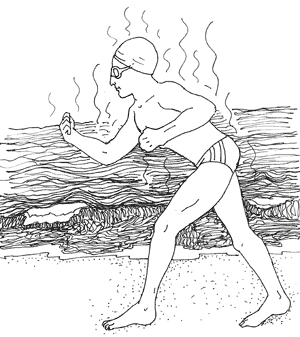STRANGE BUT TRUE- Polar bare: Icy swim just like a battle

DRAWING BY DEBORAH DERR McCLINTOCK
Q. How did British swimmer Lewis Pugh manage to beat hypothermia for the "longest polar swim" off the Antarctic coast, a mile in 30 minutes, in water barely above freezing? –E. Williams
A. Wearing only a pair of Speedos and a cap, Pugh set two records, his extensive cold-water training giving him the power of "anticipatory thermogenesis," says Popular Mechanics magazine.
While most of us maintain our bodies at 98-99 degrees F, the mere sight of cold water sends Pugh's temperature soaring to 101 F (38 C)! It takes a runner 20 minutes of hard exercise to reach this. It's a conditioned response, says National Geographic. Ahead of time, Pugh imagines all he can about the water– its color, temperature, taste of salt. He pictures swimming past icebergs but never toe-tests the water first or he couldn't get in.
"It's like going into battle," he says. "I get really revved, seriously aggressive." He doesn't think about the sharks or leopard seals but does math instead. He feels the blood rushing to protect his heart, lungs, brain, even as fingers and toes lose feeling, then on up the legs.
"Miserable, aching cold. Yet I don't consider myself a risk-taker but a risk-manager. I call it the P-factor: proper planning and preparation prevent a piss-poor performance."
Q. You have a little problem: at the racetrack, the boss sends you to fetch her some coffee– "Make sure it's good and hot"– but it's quite a walk back from the snack bar. Should you put in the cream right away, or let her do it just before drinking? Which results in hotter coffee? –P. Frosch
A. Things cool off at a rate proportional to their temperature difference with the surroundings, so if you put in the cream right away, you take the coffee down to a lower rate of cooling, eliminating the initial period of rapid energy loss. Other tips: Don't add sugar (dissolving consumes energy), don't stir (creates cooling eddies); if you do stir, don't use a metal spoon (conducts heat away). Job well done! Your boss loves the coffee, her horse wins, paying 20-to-1, and you're on a fast track for that promotion.
Q. A porter walks the heavy suitcase down the hotel hallway, wondering about its weight. Then as he tries to turn the corner, the headstrong suitcase mysteriously refuses to turn. Frightened, he drops the "possessed" suitcase and runs. What was in there? –R. Polanski
A. Noted Johns Hopkins physicist Robert Wood had set a massive flywheel to spinning and closed it inside his luggage, recounts Jearl Walker in The Flying Circus of Physics. Now as the porter rounded the corner, he was unknowingly trying to turn a massive gyroscope, whose spin axis strongly resists directional change. No doubt this put the prankster physicist in "possession" of a mighty good laugh.
Q. I've been lucky enough to see spectacular rainbows stretching from treetops to treetops. Now my dream is to see a double rainbow before I die, and I'm 46 years old. What are my odds? Is there some place I should visit to increase my chances?–J. Garland
A. Actually, "double rainbows" aren't all that rare, says University of Wyoming atmospheric scientist Robert D. Kelly. For the primary rainbow, water droplets refract the sunlight into its constituent colors just like a prism, with the light entering a drop and reflecting once internally off the surface before leaving: refract-reflect-refract. Secondary rainbows involve two internal reflections– refract-reflect-reflect-refract– so they're fainter than primary rainbows and appear outside the primary bow with colors reversed. (All rainbows appear opposite the sun, the sun behind your head.)
Two other double bow features: the sky will appear darker in the area between the two arcs and brighter inside the smaller, primary bow. Best observation places are away from visibility obstructions and where isolated thunderstorms occur with areas of clearing for the sun to break through to the rainshaft, adds the University of Arizona's Benjamin Herman. The Central Plains or southwestern U.S. are good bets, and quite good if you persist for a two-week period of summer.
Send Strange questions to brothers Bill and Rich at [email protected].
#